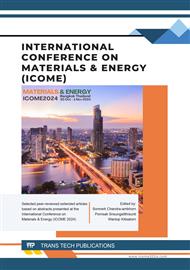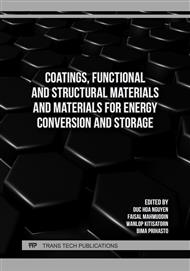[1]
M. F. Gaele and T. M. Di Palma, "Rechargeable Aluminum-Air Batteries Based on Aqueous Solid-State Electrolytes," Energy Technol., vol. 10, no. 4, 2022.
DOI: 10.1002/ente.202101046
Google Scholar
[2]
L. Yang et al., "A promising hybrid additive for enhancing the performance of alkaline aluminum-air batteries," Mater. Chem. Phys., vol. 257, no. July 2020, p.123787, 2021.
DOI: 10.1016/j.matchemphys.2020.123787
Google Scholar
[3]
F. Tong, W. Zhuang, M. Song, J. H. Kim, W. Gao, and S. Wei, "Micro-alloyed aluminium alloys as anodes for aluminium-air batteries with a neutral electrolyte," Mater. Today Commun., vol. 39, no. January, p.108518, 2024.
DOI: 10.1016/j.mtcomm.2024.108518
Google Scholar
[4]
J. Zheng et al., "Reversible epitaxial electrodeposition of metals in battery anodes," Science (80-. )., vol. 366, no. 6465, p.645–648, 2019.
DOI: 10.1126/science.aax6873
Google Scholar
[5]
W. Guo et al., "Dendrite-free Zn anode with dual channel 3D porous frameworks for rechargeable Zn batteries," Energy Storage Mater., vol. 30, no. April, p.104–112, 2020.
DOI: 10.1016/j.ensm.2020.04.038
Google Scholar
[6]
S. Hosseini, Z. Y. Liu, C. T. Chuan, S. M. Soltani, V. V. K. Lanjapalli, and Y. Y. Li, "The role of SO-group-based additives in improving the rechargeable aluminium-air batteries," Electrochim. Acta, vol. 375, p.137995, 2021.
DOI: 10.1016/j.electacta.2021.137995
Google Scholar
[7]
H. Tian et al., "Stable, high-performance, dendrite-free, seawater-based aqueous batteries," Nat. Commun., vol. 12, no. 1, p.1–12, 2021.
DOI: 10.1038/s41467-020-20334-6
Google Scholar
[8]
Y. Shen et al., "Water-in-salt electrolyte for safe and high-energy aqueous battery," Energy Storage Mater., vol. 34, no. September 2020, p.461–474, 2021.
DOI: 10.1016/j.ensm.2020.10.011
Google Scholar
[9]
D. Zhang, Y. Shi, J. Yin, and J. Lai, "Recent Advances for Seawater Hydrogen Evolution," ChemCatChem, vol. 16, no. 14, p. e202301305, Jul. 2024.
DOI: 10.1002/CCTC.202301305
Google Scholar
[10]
A. C. Lokhande, A. Shelke, P. T. Babar, J. S. Bagi, and J. H. Kim, "Studies on surface treatment of electrodeposited Ni–Zn alloy coatings using saccharin additive," J. Solid State Electrochem., vol. 21, no. 9, p.2725–2735, 2017.
DOI: 10.1007/s10008-017-3558-7
Google Scholar
[11]
M. S. D. Yati et al., "The effect of metallic oxide deposition on the electrochemical behaviour of Al-Zn-Mg-Sn alloy in natural tropical seawater," IOP Conf. Ser. Mater. Sci. Eng., vol. 60, no. 1, 2014.
DOI: 10.1088/1757-899X/60/1/012051
Google Scholar
[12]
S. Nur, S. Susanto, W. Widiyastuti, T. Nurtono, and H. Setyawan, "Materials Today : Proceedings Unravelling the deposition of Zn and Sn as corrosion inhibitor on aluminum ( Al ) surface for Al-air battery application with sodium chloride electrolytes," Mater. Today Proc., no. March, 2024.
DOI: 10.1016/j.matpr.2024.03.050
Google Scholar
[13]
R. Sitanggang, "The Enhancement Discharge Performance by Zinc Coated-Aluminum Anode for Aluminum-Air Battery in Sodium Chloride Solution," p.1–13, 2024.
DOI: 10.3390/app14146263
Google Scholar
[14]
E. B. Caldona, A. C. C. de Leon, J. D. Mangadlao, K. J. A. Lim, B. B. Pajarito, and R. C. Advincula, "On the enhanced corrosion resistance of elastomer-modified polybenzoxazine/graphene oxide nanocomposite coatings," React. Funct. Polym., vol. 123, no. June 2017, p.10–19, 2018.
DOI: 10.1016/j.reactfunctpolym.2017.12.004
Google Scholar
[15]
Q. Ran et al., "Aluminum-copper alloy anode materials for high-energy aqueous aluminum batteries," Nat. Commun., vol. 13, no. 1, p.1–9, 2022.
DOI: 10.1038/s41467-022-28238-3
Google Scholar
[16]
S. Wang, J. Zhang, O. Gharbi, V. Vivier, M. Gao, and M. E. Orazem, "Electrochemical impedance spectroscopy," Nat. Rev. Methods Prim., vol. 1, no. 1, 2021.
DOI: 10.1038/s43586-021-00039-w
Google Scholar
[17]
A. C. Lazanas and M. I. Prodromidis, "Electrochemical Impedance Spectroscopy A Tutorial," 2023.
DOI: 10.1021/acsmeasuresciau.2c00070
Google Scholar



